Channels and collaterals, or ‘jing luo’ in Chinese, are pathways that transport qi and blood, regulate yin and yang, and connect the zang-fu organs to each other and to other organs and structures of the body. The word ‘jing’ means a longitudinal as opposed to a latitudinal line. It is translated as ‘channel’ or ‘meridian’, meaning a main path or a straight line. The word ‘luo’ means ‘strings used to intertwine and tie’. It is translated as ‘collateral’ and refers to branches that separate from the channels to form a network throughout the body. The channels and collaterals intersect each other to form the channel and collateral system.
Channel and collateral theory includes the distribution, physiological functions, and pathological changes of the channels and collaterals as well as their relationship with the zang-fu organs. It is the foundation of acupuncture and moxibustion practice and an important component of the basic theory of traditional Chinese medicine. Channel theory plays a significant role in explaining the physiology and pathology of diseases and provides guidance for diagnosis, pattern differentiation, and treatment.
The channel system is comprised of twelve channels, eight extraordinary vessels, twelve channel divergences, fifteen divergent collaterals, twelve channel sinews, and twelve cutaneous regions. An overview of the system is shown in Pic. 1-1.
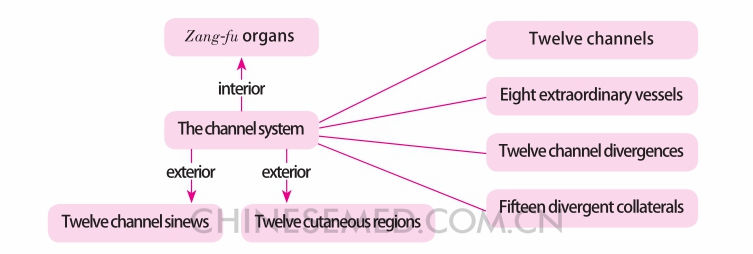
The Twelve Channels
The twelve channels are the predominant component of the channel system. They belong to their respective zang-fu organs internally and connect with the extremities, head, face, and thorax externally. Each has a specific direction to its distribution and flow and connects to the other channels through branch channels.
1. The Nomenclature of the Twelve Channels
The nomenclature of the twelve channels comprises three elements: hand/foot, yin/yang, and organ. Hand/foot refers to the external distribution and origin or termination of a channel on upper or lower limb. Yin/yang designates the nature of the channel. There are three hand/foot pairs of yin and three hand/foot pairs of yang channels. Those with the most abundant yin are called taiyin; those with a lesser amount are called shaoyin; those with the least are called jueyin. Similarly, those with the most abundant yang are called yangming; those with a lesser amount, taiyang; those with the least, shaoyang. Each yin channel is also paired with its corresponding yang channel to form six interior/exteriorly related pairs. Organ refers to the internal zang or fu organ to which the channel pertains.
In the twelve channels, qi circulates cyclically; beginning with the hand taiyin lung channel, it moves through the channels one by one. After the twelfth, the foot jueyin liver channel, it re-enters the lung channel to circulate again (Pic. 1-2).
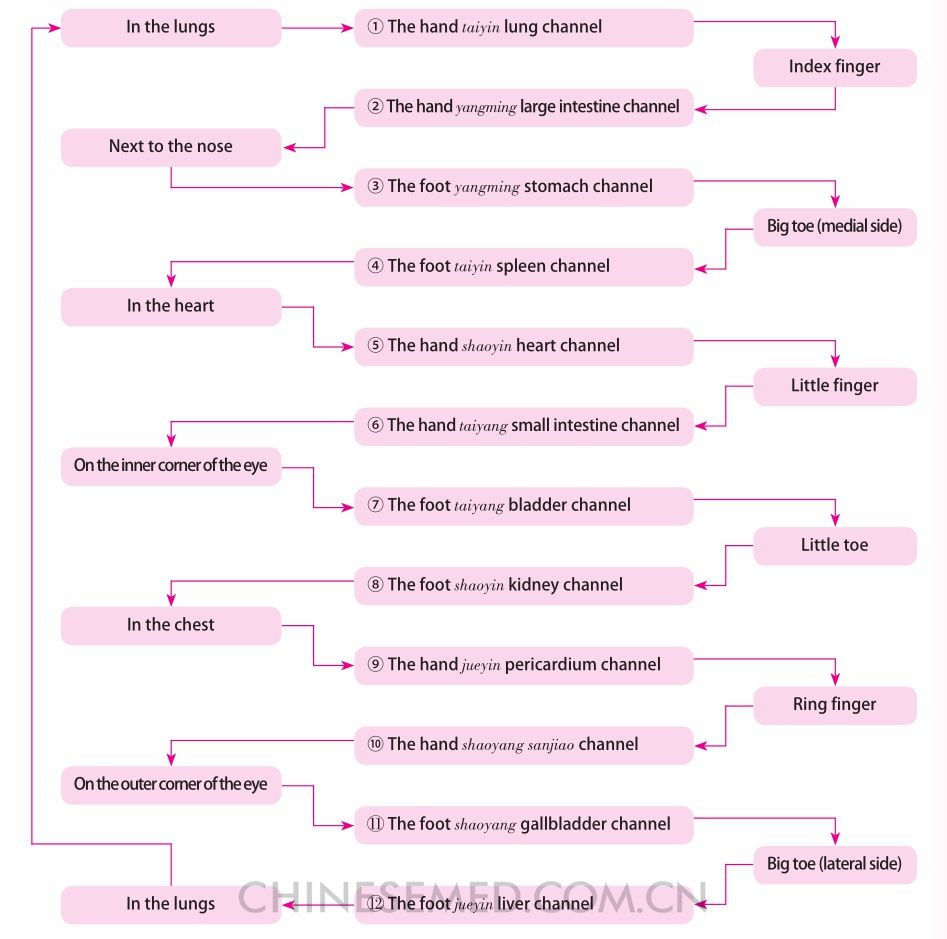
2. Distribution of the Twelve Channels
(1) Exterior distribution
Exterior distribution of the twelve channels refers to their distribution on the four limbs, trunk, face, and head.
A. The four limbs: The three yin hand channels run sequentially on the medial, or palmar, aspect of the upper limb; from anterior to posterior the order is hand taiyin, hand jueyin, and hand shaoyin. The three yang hand channels run sequentially on the lateral, or dorsal, aspect of the upper limb; from anterior to posterior the order is hand yangming, hand shaoyang, and hand taiyang. The three yin and three yang foot channels are similarly distributed on the lower limb, with the three yin foot channels ordered on the medial portion from anterior to posterior; the three yang foot channels, on the lateral aspect from anterior to posterior. In an exception to this arrangement, the foot jueyin liver channel runs anterior to the foot taiyin spleen channel until the two channels intersect eight cun above the medial malleolus; here the foot jueyin liver channel crosses to its regular position between the foot taiyin spleen and the foot shaoyin kidney channel.
B. The head, face and trunk: The three yin hand channels run from the chest to the medial, or palmar, aspect of the hand. The three yin foot channels begin at the foot and end at the abdomen and the chest region. All the yang channels either begin or end at the head and face region; as the saying goes, ‘The head is the convergence of all yang channels.’ The three yang hand channels are not externally distributed on the trunk. They begin at the lateral aspect of the hand and end at the head or face. The three yang foot channels travel from head to the foot and are the longest of the twelve channels. The foot yangming stomach channel travels on the anterior aspect of the body; the foot shaoyang gallbladder channel, on the lateral aspect; the foot taiyang bladder channel, on the posterior aspect (Pic. 1-3).
(2) Interior distribution
Interior distribution of the twelve channels refers to the portion of each channel that enters the chest and abdomen internally to connect with the related zang-fu organs and tissues. Each of the twelve channels belongs to its respective zang–fu organ. As zang organs belong to yin and fu organs belong to yang, the three yin hand channels connect with the chest and belong respectively to the lung, the pericardium, and the heart. The three yin foot channels connect with the abdomen and belong to the spleen, the liver, and the kidney. The three yang foot channels belong to the stomach, the gallbladder, and the urinary bladder. The three yang hand channels belong to the large intestine, the sanjiao, and the small intestine (Table 1-1).
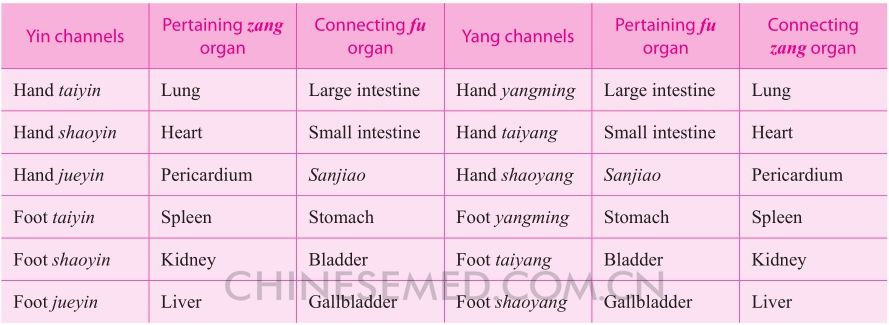

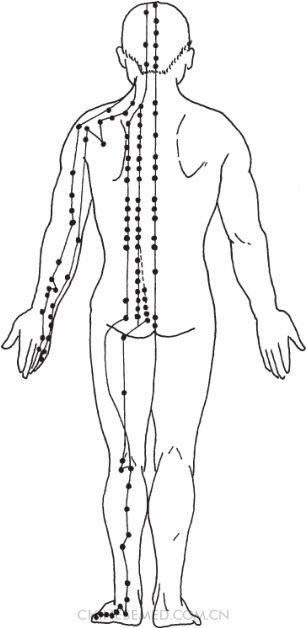
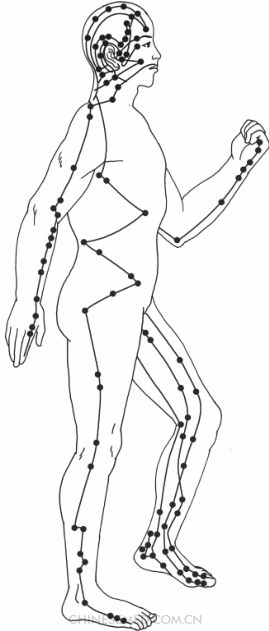
3. Exterior-Interior Relationships of the Twelve Channels
The zang and fu organs have exterior-interior relationships with each other. Because the twelve channels belong to the zang-fu organs internally, each shares an exterior-interior relationship with its corresponding zang or fu organ. The yin channels belong to the interior and to the zang organs; the yang channels, to the exterior and to the fu organs. The exterior/interior-related yin and yang channels share pertaining and connecting relationships within the body. Each yin channel pertains to a zang organ and connects to a fu organ; each yang channel pertains to a fu organ and connects to a zang organ. For example, the hand taiyin lung channel pertains to the lung and connects to the large intestine, its exterior-interiorly related organ; conversely, the hand yangming large intestine channel pertains to the large intestine and connects to the lung. According to these exterior-interior and pertaining and connecting relationships, the twelve channels are divided into six pairs:
- Hand taiyin lung and hand yangming large intestine channels
- Hand jueyin pericardium and hand shaoyang sanjiao channels
- Hand shaoyin heart and hand taiyang small intestine channels
- Foot taiyin spleen and foot yangming stomach channels
- Foot jueyin liver and foot shaoyang gallbladder channels
- Foot shaoyin kidney and foot taiyang bladder channels
The exterior-interior relationships of the twelve channels are also strengthened by the channel divergences and collaterals, which facilitate communication and strengthen the connections between the interior- and exterior-related organs and the relevant parts and regions of the body.
4. Flow and Entry of Qi and Blood into the Twelve Channels
Movement of qi and blood inside a channel is known as ‘flow’; influx of qi and blood from one channel to another is known as ‘entry’. The general rule is that the three yin hand channels travel from chest to hands; the three yang hand channels, from hands to head; the three yang foot channels, from head to feet; the three yin foot channels, from feet to abdomen or chest. The connections between the twelve channels also follow a pattern:
(1) The exterior-interiorly related channels connect at the extremities; e.g., the hand taiyin lung channel and hand yangming large intestine channel connect at the tip of the radial side of the index finger.
(2) Hand and foot yang channels with the same nomenclature connect at the head and facial region; e.g., the hand and foot yangming channels connect next to the nose.
(3) The yin hand and foot channels connect inside the chest; e.g., the foot taiyin spleen channel connects with the hand shaoyin heart channel inside the heart.
Based on their distribution and conjunction, the twelve regular channels connect with each other to form a closed system (Pic. 1-2).
Qi and blood flows continuously inside the closed loop formed by the connection of the twelve channels in a circulation affected by the patterns of nature. For example, the day may be divided into twelve two-hour intervals: the flow of qi and blood in each channel correlates to one interval, after which it moves to the next channel following the natural cycle of the earth’s movement around the sun. This concept is the foundation of stem-branch acupuncture. The ren mai and du mai of the eight extraordinary vessels were later incorporated into the loop system to form the circulation of the fourteen channels (Pic. 1-4).
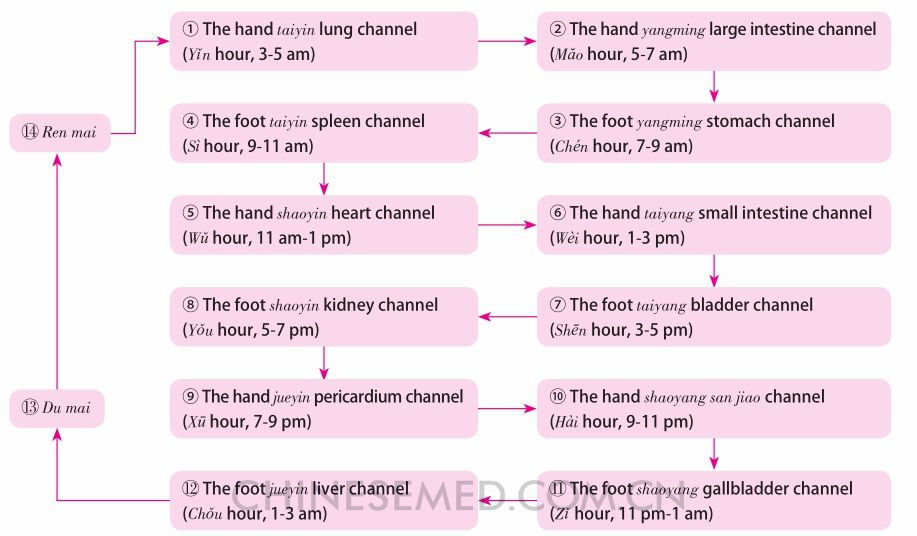
The Eight Extraordinary Vessels
The eight extraordinary vessels, du mai, ren mai, chong mai, dai mai, yangqiao mai, yinqiaomai, yangwei mai, and yinwei mai, have unique functions, including governing, connecting, and regulating qi and blood within the channels. They differ from the twelve channels in that they do not belong directly to zang-fu organs and have no exterior-interior relationships. However, they are closely related to extraordinary fu organs such as the uterus, brain, and marrow, and they intersect the twelve channels. Du mai runs along the posterior midline; ren mai travels the anterior midline. Like the twelve channels, the du mai and ren mai have points of their own. Thus they are often grouped with the twelve channels into the arrangement known as the fourteen channels. With no points of their own, the remaining six mai connect with the fourteen channels at various points throughout the body. Chong mai runs along the first lateral line on the abdomen, where it connects with foot shaoyin kidney channel points. The ren mai, du mai, and chong mai all originate in the uterus (uterus in females; essence chamber in males). These three channels emerge at the perineum and separate thereafter; hence the saying, ‘one origin and three divisions’. The dai mai encircles the waist and the abdomen obliquely like a belt and intersects points on the foot shaoyang gallbladder channel. Yangqiao mai runs laterally up the lower limbs and ascends to the shoulder and head; it intersects points on channels such as the foot taiyang bladder channel. The yinqiao mai travels on the medial aspect of the lower limbs and ascends to the head, face, and eye; it intersects the foot shaoyin kidney channel. The yangwei mai travels laterally on the lower limbs and ascends to the shoulder, head, and nape of the neck; it intersects points on channels such as the foot taiyang bladder channel and the dumai. The yinwei mai travels on the medial aspect of the lower limbs and along the third lateral line of the abdomen to the neck; it intersects points on channels such as the foot shaoyin kidney channel and the ren mai (see Table 1-2).
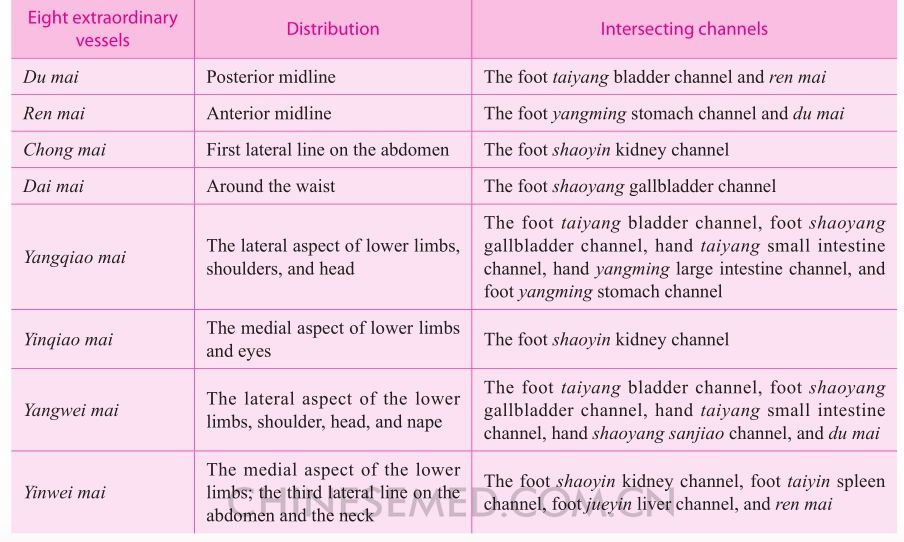
Twelve Channel Divergences
The twelve channel divergences are major branches of the twelve channels. They strengthen the connection between the exterior-interiorly related channels and the corresponding zang-fu organs. The distribution of the twelve channel divergences follows a regular pattern that may be summarized as ‘separating’, ‘entering’, ‘emerging’, and ‘merging’. Separating refers to branching off from one of the twelve regular channels; this usually occurs near joints of elbow and knee. Entering means entrance into the chest or abdominal cavity to connect with the exterior-interiorly related zang-fu organs. The three divergent yang foot channels also connect with the heart. Emerging refers to emergence from above the chest cavity. Merging means union with a primary yang channel at the head and facial regions: the yin channel divergences merge with their respective exterior-interiorly related yang channels; each yang divergence rejoins its own primary channel. For example, the foot yangming divergence separates from the foot yangming stomach channel at the anterior aspect of the thigh, enters the abdominal cavity, enters its pertaining organ, the stomach, disperses in the spleen, and ascends to the heart. It emerges from the chest and merges with the foot yangming stomach channel at the face. There are six pairs of channel divergences; these are known as the ‘six confluences’. Through the process of separating, entering, emerging, and merging, the channel divergences strengthen the connections among the channels and organs.
The channel divergence theory emphasizes the connection between the primary channels with important organs and structures such as the heart and the head and expands the scope of the channels. Although the divergences have no specific points of their own and thus do not directly treat clinical disorders, this theory also expands the clinical functions of the acupoints.
Fifteen Collateral Vessels
The fifteen collateral vessels include the twelve collaterals, each of which corresponds to one of the twelve regular channels, plus a collateral each for ren mai on the front, du mai on the back, and the major collateral of the spleen on the lateral trunk. The collaterals percolate and infuse qi and blood through exterior and interior channels. The channel divergences of the twelve channels separate from their respective main channels at their luo-connecting points on the limbs and connect with their exterior-interiorly paired channels. They strengthen the connections between the exterior-interior pairs at the extremities and reach areas of the body not supplied by the twelve channels. The three collaterals on the trunk cover the anterior, posterior, and lateral regions of the body. The divergent collaterals are branches of the main channels and serve to strengthen the connection between exterior-interiorly paired channels at the extremities. The collateral vessels are responsible for the exterior; each has its own luo-connecting point, which has specific clinical applications.
Twelve Channel Sinews
The channel sinews correspond to the tendons and muscles along the channel system. Sinews are muscles that exert strength; tendons connect muscle to bone. The channel sinew distribution pattern largely follows that of the twelve channels. In general, the twelve channel sinews originate at the extremities and bind at the bones and joints.
Some enter the chest or abdominal cavity, but they do not belong to or connect with zang-fu organs as do the regular channels. The hand and foot yang channel sinews go to the head and face, the three hand yin channel sinews go to the chest and diaphragm, and the three foot yin channel sinews go to the external genitalia. The channel sinews restrain the bones, hold the internal organs in position, and coordinate the movements of the body. Some channel sinews also expand the distribution and connections of the channels; e.g., the hand yangming large intestine channel goes to the teeth, mouth, and nose, while the hand yangming channel sinew goes to the temple, connects with the head, and descends to the cheek on the opposite side so that the right and left channels cross. The main symptoms of a channel sinew disorder are cramping and pain along the channel and where it binds. These symptoms are treated with points on the corresponding primary channel.
Twelve Cutaneous Regions
The twelve cutaneous regions are the regions of skin that correspond to the twelve channels and their collaterals. The surface of the human body is divided into twelve regions according to the distribution of the twelve channels; these form the twelve cutaneous regions. Channel distribution is linear, while the collaterals form a network. The cutaneous regions constitute the outermost shield of the human body and protect the body against pathogens under normal circumstances. A disorder can progress from the cutaneous region to the collaterals, move to the channel, then to its fu organ, and finally to its zang organ. Disorders of zang-fu organs and channels can also be reflected at cutaneous regions. Thus internal disorders may be diagnosed by examining the changes in color and appearance at the cutaneous regions and collaterals. During treatment, a cutaneous region may be stimulated to regulate the respective channel, collaterals, and zang-fu organ. Certain needling techniques and therapeutic methods such as dermal needling, collateral bloodletting, and hot compress therapy are clinical applications of the theory of the twelve cutaneous regions.

